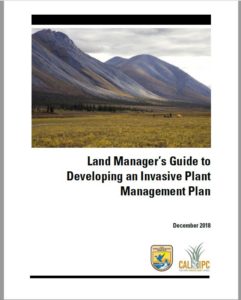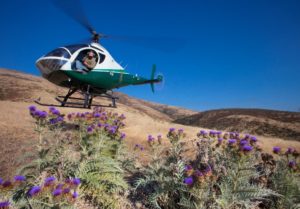 This manual is a comprehensive guide for land managers to use when developing invasive plant management plans. It is designed to be applicable at any scale and to help you create a final product that is strategic, integrative, and adaptive to changing conditions. The guide was developed as a collaboration between the US Fish and Wildlife Service, Cal-IPC, and an expert advisory team of 27 invasive plant and land management experts. It lays out a step-wise, easy-to-follow process to completing a plan, highlighting key questions and issues that should be addressed along the way.
This manual is a comprehensive guide for land managers to use when developing invasive plant management plans. It is designed to be applicable at any scale and to help you create a final product that is strategic, integrative, and adaptive to changing conditions. The guide was developed as a collaboration between the US Fish and Wildlife Service, Cal-IPC, and an expert advisory team of 27 invasive plant and land management experts. It lays out a step-wise, easy-to-follow process to completing a plan, highlighting key questions and issues that should be addressed along the way.
This manual is available as a free download. Click here for a PDF of BMPs for Developing an Invasive Plant Management Plan. (76 pp., 5.29MB)
- Contents:
- How to Use this Guide
- Introduction to Invasive Plant Management
- Preparing to Write a Plan
- Purpose and Spatial Scope
- Identifying Project Teams
- Review of site-specific information
- Review of regulatory compliance issues
- Analyzing and Designing a Management Strategy
- Identifying species and areas
- Evaluating status of species and areas
- Developing objectives and strategies
- Avoiding unintended impacts
- Planning work
- Monitoring and Reporting
- Writing Your Plan
- Adapting Your Plan
- Links and attached reference material and resources

Aerial invasive plant survey. Photo courtesy of Wildlands Conservation Science, LLC.
Invasive Plant Management Plans Referenced in Appendix B:
Dendra (2012). Management Priorities for Invasive Non-native Plants: A Strategy for Regional Implementation, San Diego County, California.
Evans et al. (2003). Invasive Plant Species Inventory and Management Plan for the Hanford Reach National Monument.
Hall (2015). Integrated Vegetation Management Plan for Open Space Lands of the City of San Luis Obispo.
Hogle et al. (2007). San Pablo Bay National Wildlife Refuge Lepidium latifolium Control Plan.
Marriott et al. (2013). South San Francisco Bay Weed Management Plan.
May and Associates (2015). Vegetation and Biodiversity Management Plan: Marin County Parks and Open Space District.
Midpeninsula Regional Open Space District (2014). Midpeninsula Region Open Space District Integrated Pest Management Program Guidance Manual.
National Park Service (2003). Rocky Mountain National Park Invasive Exotic Plant Management Plan and Environmental Assessment.
National Park Service (2008). Lassen Volcanic National Park Weed Management Plan and Environmental Assessment.
National Park Service (2010). Yosemite National Park Invasive Plant Management Plan Update Environmental Assessment.
National Park Service (2018). Yosemite Invasive Plant Management Program 2018 Work Plan.
National Park Service (2017). Invasive Plant Management Plan and Environmental Assessment for Redwood National Park and Santa Monica Mountains National Recreation Area.
Shelterbelt Builders and MIG/TRA Environmental Sciences (2016). Integrated pest management plan for the Bear Creek Redwoods Open Space Preserve.
U.S. Fish and Wildlife Service (2012). Integrated Pest Management Plan for Chesapeake Marshlands National Wildlife Refuge Complex.
Additional Resource: Training Session Presentation
With funding from Western-IPM, Cal-IPC and US Fish and Wildlife Service led a training session based on this guide at the 2020 Cal-IPC Symposium. Download the PowerPoint of the training session “Developing an Invasive Plant Management Plan for your Organization.” (29.2 MB)
Acknowledgements
Developing the Guide would not have been possible without the work of invasive species innovators and practitioners who continually strive to increase our success in managing invasive species and who share what they learn. In addition to the technical advisory committee, several other invasive species management experts within the U.S. Fish and Wildlife Service provided important feedback during development of this Guide, including Laura Eaton (Region 5), Geoffrey Grisdale (Region 8), John Klavitter (Region 9), William G. Thomas (Region 4), Karen Viste-Sparkman (Region 3), and Heather Whitlaw (Region 4). Funding for this work was provided by the U.S. Fish and Wildlife Service, National Wildlife Refuge System, Pacific Southwest Region, Inventory and Monitoring Initiative, Sacramento, California.
Civil Rights
In accordance with Federal law and U.S. Department of Agriculture policy, Cal-IPC is prohibited from discrimination on the basis of race, color, national origin, sex, age or disability. (Not all prohibited bases apply to all programs.) To file a complaint of discrimination, write USDA, Director, Office of Civil Rights, Room 326-W, Whitten Building, 1400 Independence Avenue, SW, Washington DC 20250-9410 or call (202) 720-5964 (voice and TDD). USDA is an equal opportunity provider and employer.fic Southwest Region, Inventory and Monitoring Initiative, Sacramento, California.
Please cite this report as:
U.S. Fish and Wildlife Service and California Invasive Plant Council. 2018. Land Manager’s Guide to Developing an Invasive Plant Management Plan. Cal-IPC Publication 2018-01. National Wildlife Refuge System, Pacific Southwest Region, Inventory and Monitoring Initiative, Sacramento, CA. California Invasive Plant Council, Berkeley, CA. Available at www.cal-ipc.org and data.gov.
For more information, contact Cal-IPC.
